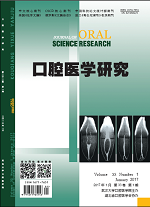|
|
Clinical Observation and Experimental Study of Minqing Ao Dental Desensitizer Combined with Er:YAG Laser on the Treatment of Dentine Hypersensitivity in Teenagers.
LIU Zi-han, ZHOU Shu, ZHENG Hong, TANG Gen-xiong
2017, 33(1):
90-94.
DOI: 10.13701/j.cnki.kqyxyj.2017.01.021
Objective: To study the clinical effect of Minqing Ao dental desensitizer combined with Er : YAG laser on the treatment of dentine hypersensitivity in teenagers. Methods: Seventy-eight cases (163 teeth) of dentine hypersensitivity in teenagers were randomly divided into the Minqing Ao group (n=54), the laser group (n=55) and the combined group (n=54). The Minqing Ao group was treated with Minqing Ao dental desensitizer alone, the laser group was treated with Er:YAG laser irradiation, and the combined group was treated with Er:YAG laser irradiation combined with the later Minqing Ao dental desensitizer. The visual analog scale (VAS) and total effective rate of the Minqing Ao group, the laser group and the combined group were compared before, immediately after, and 1 week, 1, 3, 6 months after treatment. Another 20 fresh teeth were selected and randomly divided into four groups. The dentin hypersensitivity model samples of four groups were treated by using normal saline, Minqing Ao dental desensitizer, Er:YAG laser, Minqing Ao dental desensitizer combined with Er:YAG laser respectively. Sample morphology of all 20 specimens was observed under scanning electron microscope. Results: The VAS of the combined group was significantly lower than that in the Minqing Ao group and in the laser group (P<0.05). Total effective rate of the combined group was significantly lower than that in the Minqing Ao group and the laser group immediately after and 1 week, 1, 3, 6 months after treatment (P<0.05). Total effective rate of the Minqing Ao
基金项目 江苏省卫生厅预防医学科研课题基金资助项目(编号:Y2013003)
作者简介 刘子晗(1987~ ),女,江苏连云港人,硕士,住院医师,主要从事口腔科的临床治疗工作。
*通讯作者 周淑,E-mail:13951878582@163.com
group and the laser group immediate after and 1 week, 1 month, 3 months after treatment showed no statistical significance. Conclusion: Minqing Ao dental desensitizer combined with Er:YAG laser in the treatment of dentine hypersensitivity in teenagers has better clinical effects.
References |
Related Articles |
Metrics
|

